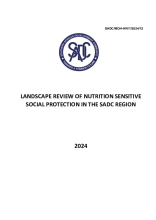In the Southern African Development Community (SADC) Region, child malnutrition poses a significant socio-economic challenge, with six out of sixteen Member States exhibiting high stunting prevalence (20% to <30%) and eight showing very high prevalence (≳30%).2 Further, in sub-Saharan Africa (SSA) only 23% of children aged 6 to 23 months meet minimum dietary diversity and 44% meet minimum meal frequency. 3 Three-quarters of Member States report a prevalence of anaemia in pregnant women exceeding 20%, which is a level of public health concern according to the World Health Organization (WHO). 4 Lastly, being overweight in children under five years is a growing concern with five Member States’ prevalence classified as high.
Addressing this triple burden of malnutrition necessitates a comprehensive systems approach. Food insecurity, poverty, and undernutrition are intricately linked, with malnutrition serving as both a contributing factor to and a consequence of poverty. Social protection emerges as part of a comprehensive package of multi-system interventions to address monetary poverty and lack of availability of nutritious foods as key drivers of malnutrition. Example programmes include food baskets, cash transfers, and meals through school feeding programmes. These initiatives can be made nutrition-sensitive by explicitly integrating nutrition-related objectives, targeting the most nutritionally vulnerable and acting as platforms for additional multi-sectoral nutrition-specific interventions.
AIM AND OBJECTIVES
This study aimed to identify gaps and assess opportunities within existing policy and programmes for nutrition-sensitive social protection in the Region. By focusing on these opportunities, the study looked to showcase case studies of Member States that are making progress in this aspect and provide comprehensive recommendations covering policy, governance structures, implementation, and monitoring and evaluation to support the scale up nutrition-sensitive social protection. This approach is designed to strengthen support for enhanced nutrition outcomes for women and children.
Specific objectives included:
1. To provide an overview of the state of nutrition-sensitive social protection policies and programmes in the SADC Region across policy, governance, financing, programmes, and monitoring and evaluation.
2. To identify the most positively impactful maternal and child nutrition indicators and/or promising social assistance programmes reaching nutritionally vulnerable groups across the SADC Region, with a focus on gender-responsive and inclusive approaches and the supporting governance environment in which they have been embedded.
3. To identify innovations in the design, implementation, and monitoring of nutrition-sensitive SPPs in the SADC Region.
4. To determine feasible options for scale-up and dissemination to improve policy and programme design and implementation by embedding both nutrition-specific and nutrition-sensitive interventions into policies and programmes.

